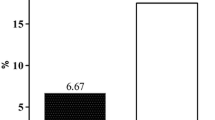Abstract
Aims: The exact pathogenesis and prophylaxis concerning radiocontrast-induced nephrotoxicity (RCIN) was unclear. Short-acting calcium antagonists were used to prevent RCIN. This study was designed to evaluate the role of a long-acting calcium antagonist (amlodipine) administration by determining serum creatinine (SCre) levels and 24 hour urinary excretion rates of glutathione S-transferase alpha (GST-α) which has a selective localization only to proximal tubular epithelium.Methods: In a prospective trial, 29 outpatients (19 M, 10 F) undergoing coronary angiography were randomized and either amlodipine 10 mg/day (n = 15) or placebo (n = 14) were administered prior to angiography and continued thereafter. All patients had normal basal renal function and none of them had any risk factor for RCIN. A low osmolar, nonionic contrast media (iopamidol 76%) was administered to all patients. Creatinine clearance (CCre), SCre and 24-hour urinary GST-α levels were measured before, 24 hours and 7 days after angiography.Results: SCre and 24 hour urinary GST-α values increased on 24th hour following the angiography in both groups (p < 0.017 and 0.001, respectively). Pretreatment with amlodipine created no difference in both variables (p > 0.05).Conclusions: A reversible tubular dysfunction occurs following radiocontrast administration which was manifested by an increase in urinary GST-α excretion rates. Pretreatment with a long acting calcium antagonist amlodipine has no effect on the course of enzyme excretion and alteration observed in SCre
Similar content being viewed by others
References
Hou SH, Bushinsky DA, Wish JB, Cohen JJ, Harrington JT. Hospital-acquired renal insufficiency: a prospective study. Am J Med 1983; 74: 243-248.
Rudnick MR, Berns JS, Cohen RM, Goldfarb S. Contrast media-associated nephrotoxicity. Semin Nephrol 1997; 17: 15-26.
Talner LB, Davidson AJ. Renal hemodynamic effects of contrast media. Invest Radiol 1968; 3: 310-317.
Katzberg RW, Morris TW, Bengener FA, Kamm DE, Fischer HW. Renal rennin and hemodynamic responses to selective renal artery catheterization and angiography. Invest Radiol 1977; 12: 381-388.
Moreau JF, Droz D, Noel LH, Leibowitch J, Jungers P, Micker JR. Tubular nephrotoxicity of water-soluble iodinated contrast media. Invest Radiol 1980; 15(Suppl 6): S54-S60.
Humes HD, Hunt DA, White MD. Direct toxic effect of the radiocontrast agent diatrizoate on renal proximal tubule cells. Am J Physiol 1987; 252: F246-F255.
Danford RO, Talner LB, Davidson AJ. Effect of graded osmolatities of saline solution and contrast media on renal extraction of PAH in the dog. Invest Radiol 1969; 4: 301-304.
Deray G, Martinez F, Cacoub P, Barmelou B, Jacobs C. A role for adenosine calcium and ischemia in radiocontrast-induced intrarenal vasoconstriction. Am J Nephrol 1990; 10: 316-322.
Bakris GL, Burnett JC Jr. A role for calcium in radiocontrastinduced reductions in renal hemodynamics. Kidney Int 1985; 27: 465-468.
Neumayer H-H, Junge W, Küfner A, Wenning A. Prevention of radiocontrast-media-induced nephrotoxicity by the calcium channel blocker nitrendipine: a prospective randomized trial. Nephrol Dial Transplant 1989; 4: 1030-1036.
Russo D, Testa A, Volpe LD, Sansone G. Randomised prospective study on renal effects of two different contrast media in humans: protective role of a calcium channel blocker. Nephron 1990; 55: 254-257.
Davidson CJ, Hlatky M, Morris KG, Pieper K, Skelton TN, Schwab SJ, Bashore TM. Cardiovascular and renal toxicity of a nonionic radiographic contrast agent after cardiac catheterization. Ann Intern Med 1989; 110: 119-124.
Carraro M, Mancini W, Artero M, Stacul F, Grotto M, Faccini L. Dose effect of nitrendipine on urinary enzymes and microproteins following non-ionic radiocontrast administration. Nephrol Dial Transplant 1996; 11: 444-448.
Sundberg AGM, Nilsson R, Appelkvist EL, Dallner G. Immunohistochemical localization of α and π class glutathione transferases in normal human tissues. Pharmacol Toxicol 1993; 72: 321-331.
Solomon R, Werner C, Mann D, D'Elia J, Silva P. Effects of saline, mannitol, and furosemide on acute decreases in renal function induced by radiocontrast agents. New Engl J Med 1994; 331: 1416-1420.
Sundberg AGM, Nilsson R, Appelkvist E-L, Dallner G. ELISA procedures for the quantitation of glutathione transferases in the urine. Kidney Int 1995; 48: 570-575.
Mannervik B. The isoenzymes of glutathione transferase. In Meister A ed. Advances in Enzymology and Related Areas of Molecular Biology. New York: John Wiley and Sons, 1985: vol 57, 357-417.
Sundberg AGM, Appelkvist E-L, Backman L, Dallner G. Urinary π-class glutathione transferase as an indicator of tubular damage in the human kidney. Nephron 1994; 67: 308-316.
Sundberg A, Appelkvist E-L, Dallner G, Nilsson R. Glutathione transferases in the urine: sensitive methods for detection of kidney damage induced by nephrotoxic agents in humans. Environ Health Perspect 1994; 102(Suppl3): 293-296.
Goldstein EJ, Feinfeld DA, Fleischner GM, Elkin M. Enzymatic evidence of renal tubular damage following renal angiography. Radiology 1976; 121: 617-619.
Feinfeld DA, Bourgoignie JJ, Fleischner G, Goldstein EJ, Biempica L, Arias IM. Ligandinuria in nephrotoxic acute tubular necrosis. Kidney Int 1977; 12: 387-392.
Donadio C, Chella P, Tramonti G, Luchessi A, Giordani R, Magagnini E, Bianchi C. Cardiac angiography: renal effects of contract media. Nephrol Dial Transplant 1996; 11: A86.
Haria M, Wagstaff AJ. Amlodipine: a reappraisal of its pharmacological properties and therapeutic use in cardiovascular disease. Drugs 1995; 50: 560-586.
Epstein M. Calcium antagonists and the kidney. Implications for renal protection. Am J Hypertens 1993; 6: 251S-259S.
Arici M, Erdem Y, Altun B, Balkanci F, Yasavul Ñ, Turgan Ç, Çaðlar i. Severe renal vasoconstriction and anuria following intravenous urography in a patient with renal impairment. Am J Kid Dis 1996; 28: 454-456.
Porter GA. Effects of contrast agents on renal function. Invest Radiol 1993; 28(Suppl 5): S1-S5.
Author information
Authors and Affiliations
Rights and permissions
About this article
Cite this article
Arıcı, M., Usalan, C., Altun, B. et al. Radiocontrast-induced nephrotoxicity and urinary alpha-glutathione S-transferase levels: Effect of amlodipine administration. Int Urol Nephrol 35, 256–261 (2003). https://doi.org/10.1023/B:UROL.0000020186.72345.ec
Issue Date:
DOI: https://doi.org/10.1023/B:UROL.0000020186.72345.ec




